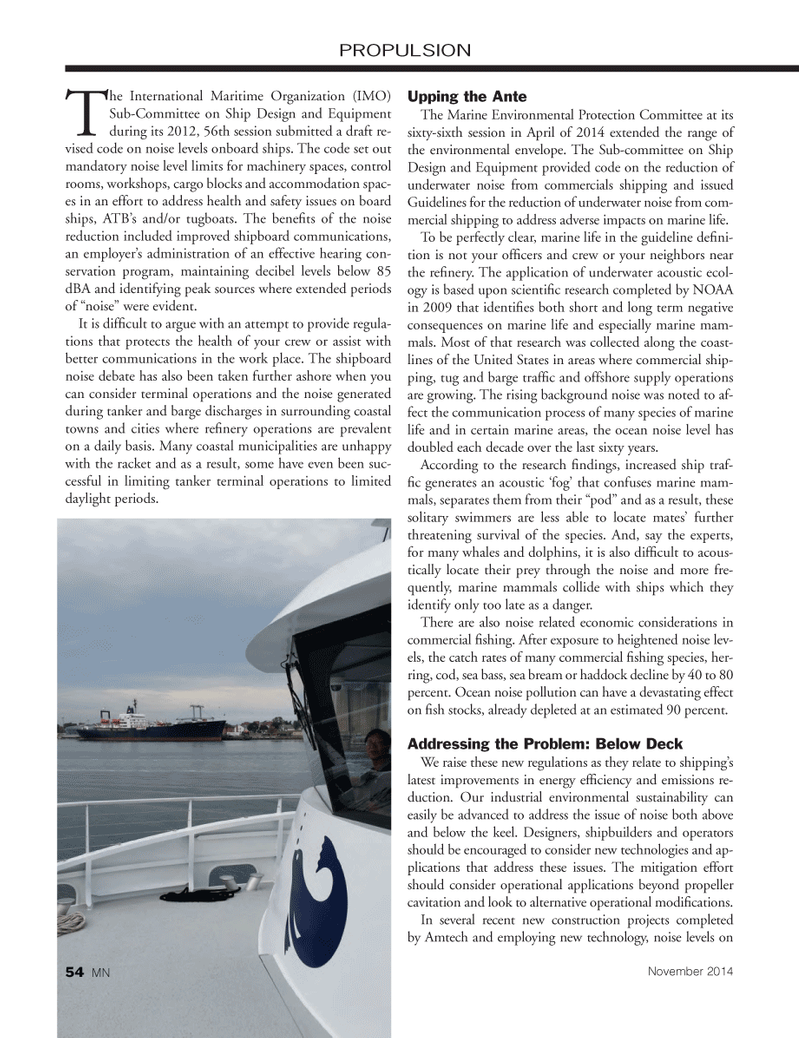
Page 54: of Marine News Magazine (November 2014)
Workboat Annual
Read this page in Pdf, Flash or Html5 edition of November 2014 Marine News Magazine
T he International Maritime Organization (IMO)
Sub-Committee on Ship Design and Equipment during its 2012, 56th session submitted a draft re- vised code on noise levels onboard ships. The code set out mandatory noise level limits for machinery spaces, control rooms, workshops, cargo blocks and accommodation spac- es in an effort to address health and safety issues on board ships, ATB’s and/or tugboats. The benefi ts of the noise reduction included improved shipboard communications, an employer’s administration of an effective hearing con- servation program, maintaining decibel levels below 85 dBA and identifying peak sources where extended periods of “noise” were evident.
It is diffi cult to argue with an attempt to provide regula- tions that protects the health of your crew or assist with better communications in the work place. The shipboard noise debate has also been taken further ashore when you can consider terminal operations and the noise generated during tanker and barge discharges in surrounding coastal towns and cities where refi nery operations are prevalent on a daily basis. Many coastal municipalities are unhappy with the racket and as a result, some have even been suc- cessful in limiting tanker terminal operations to limited daylight periods.
Upping the Ante
The Marine Environmental Protection Committee at its sixty-sixth session in April of 2014 extended the range of the environmental envelope. The Sub-committee on Ship
Design and Equipment provided code on the reduction of underwater noise from commercials shipping and issued
Guidelines for the reduction of underwater noise from com- mercial shipping to address adverse impacts on marine life.
To be perfectly clear, marine life in the guideline defi ni- tion is not your offi cers and crew or your neighbors near the refi nery. The application of underwater acoustic ecol- ogy is based upon scientifi c research completed by NOAA in 2009 that identifi es both short and long term negative consequences on marine life and especially marine mam- mals. Most of that research was collected along the coast- lines of the United States in areas where commercial ship- ping, tug and barge traffi c and offshore supply operations are growing. The rising background noise was noted to af- fect the communication process of many species of marine life and in certain marine areas, the ocean noise level has doubled each decade over the last sixty years.
According to the research fi ndings, increased ship traf- fi c generates an acoustic ‘fog’ that confuses marine mam- mals, separates them from their “pod” and as a result, these solitary swimmers are less able to locate mates’ further threatening survival of the species. And, say the experts, for many whales and dolphins, it is also diffi cult to acous- tically locate their prey through the noise and more fre- quently, marine mammals collide with ships which they identify only too late as a danger.
There are also noise related economic considerations in commercial fi shing. After exposure to heightened noise lev- els, the catch rates of many commercial fi shing species, her- ring, cod, sea bass, sea bream or haddock decline by 40 to 80 percent. Ocean noise pollution can have a devastating effect on fi sh stocks, already depleted at an estimated 90 percent.
Addressing the Problem: Below Deck
We raise these new regulations as they relate to shipping’s latest improvements in energy effi ciency and emissions re- duction. Our industrial environmental sustainability can easily be advanced to address the issue of noise both above and below the keel. Designers, shipbuilders and operators should be encouraged to consider new technologies and ap- plications that address these issues. The mitigation effort should consider operational applications beyond propeller cavitation and look to alternative operational modifi cations.
In several recent new construction projects completed by Amtech and employing new technology, noise levels on
PROPULSION
November 2014 54 MN
MN Nov14 Layout 50-65.indd 54 10/23/2014 10:38:41 AM

 53
53

 55
55
